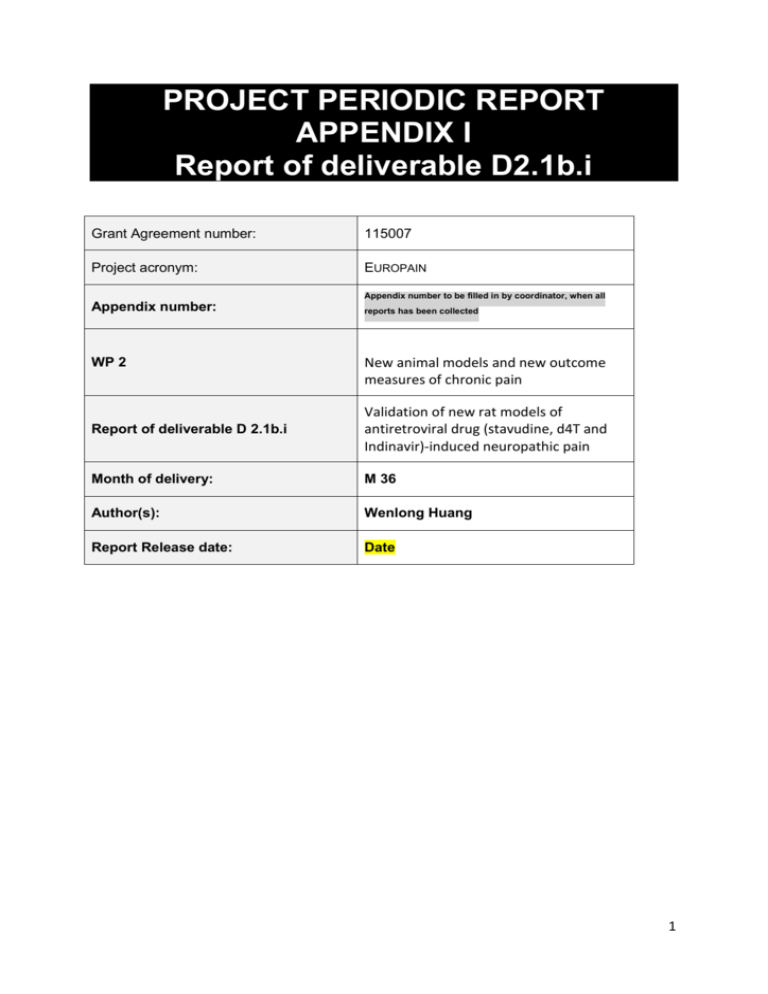Summary - figshare
advertisement

PROJECT PERIODIC REPORT APPENDIX I Report of deliverable D2.1b.i Grant Agreement number: 115007 Project acronym: EUROPAIN Appendix number to be filled in by coordinator, when all Appendix number: WP 2 reports has been collected New animal models and new outcome measures of chronic pain Report of deliverable D 2.1b.i Validation of new rat models of antiretroviral drug (stavudine, d4T and Indinavir)-induced neuropathic pain Month of delivery: M 36 Author(s): Wenlong Huang Report Release date: Date 1 Contents Summary………………………………………………………………………………. 2 Background and objective…………………………………………………………….. 2 Study design…………………………………………………………………………… 2 Results…………………………………………………………………………………. 2 Objectives achieved…………………………………………………………………… 3 Deviations………………………………………………………………………………3 Publications……………………………………………………………………………. 3 Summary We have shown that rats treated with the key antiretroviral drug stavudine (d4T), developed a persistent painful peripheral sensory, but not motor, neuropathy, mirroring a major clinical problem in HIV disease management. In keeping with the clinical presentation, we have demonstrated simple reflex pain behaviour that is appropriately sensitive to pharmacological perturbation as well as complex pain behaviours. Furthermore, we have shown, using histology, that this neuropathy is characterized by an axonal retraction from the skin and also a novel finding of central spinal axonal retraction, which has important implications for the pathology of this condition. We have also shown that glial and immune cell responses, characteristic of nerve injury, are minor features of d4T neurotoxicity, thus calling into question the direct generic relationship of such phenomena with pain-related behaviours. We have also examined the axonal proteomic response to d4T treatment. Importantly, we have shown that this neurotoxicity occurs independently of HIV infection, a confound that is difficult to dissect in humans since the two conditions co-exist as the interaction between HIV and sensory neurons is also the cause of a painful neuropathy. We have shown that rats treated with the protease inhibitor Indinavir developed hindpaw mechanical and cold hypersensitivity, but not heat hypersensitivity. There appeared to be an increased thigmotaxis behaviour following Indinavir treatment. Initial histological examination revealed a loss of hindpaw intra-epidermal nerve fibres and an infiltration of macrophages in the L4 DRG following Indinavir treatment. Further experiments are needed to characterise the thigmotaxis behavioural and histological changes. Background and objective HIV-associated sensory neuropathy (HIV-SN) is the most frequent neurological manifestation of HIV disease and is seen in 40-50% of patients whose HIV disease is otherwise well controlled by antiretroviral therapy (ART). It is a distal symmetrical, predominantly sensory, polyneuropathy and is associated with significant neuropathic pain. HIV-SN can result from: the HIV glycoprotein gp120 and/or ART such as the nucleoside reverse transcriptase inhibitors (NRTIs). The NRTI d4T remains in the first-line HIV treatment in many resourcelimited countries due to its high effectiveness and inexpensiveness. Its neurotoxicity has been reported in HIV patients, uninfected subjects receiving prophylaxis, and animal studies. Continued d4T use as an economic reality will result in on-going high rates of HIV-SN, particularly in resource-limited settings. Furthermore, a very large proportion of people living with HIV in well-resourced settings have been exposed to d4t. HIV patients have limited peripheral nerve regenerative capacity, suggesting that existing HIV-SN cases caused by d4T use are likely to persist for life as past d4T exposure is a major risk factor for HIV-SN long 2 after exposure to the drug has ceased. Considering that patients with access to modern ART now enjoy a near-normal life expectancy, global HIV-SN burden will remain high. HIV-SN has a negative impact on patients’ quality of life. The CHARTER study has revealed strong associations of disability in daily activities and depression with painful HIV-SN. In a broader context, anxiety, depression, and cognitive impairment are recognised as being associated with chronic pain, but these pain-associated co-morbidities have not been adequately addressed in animal models. A model of painful HIV-SN with the NRTI zalcitabine has been described previously. However, no studies have assessed pain-associated co-morbidities in animal models of d4T-induced HIV-SN to mimic the current clinical scenario of d4T use, nor have detailed neuropathology following d4T treatment been described. Recent studies have shown that the prevalence of HIV-SN does not decline even in resource rich countries where neurotoxic NRTI drugs including d4T are no longer being used, suggesting there are other important factors that may contribute to the development of HIVSN in NRTI drug naïve patients. One possibility is the toxicity of other drugs being used in ART, e.g. the protease inhibitors. Evidence has suggested that exposure to indinavir, a protease inhibitor commonly used as a part of the ART, is associated with high prevalence of HIV-SN. In vitro studies have shown neurotoxicity in cultured adult rat dorsal root ganglion cells when exposed to indinavir. The objective of the deliverables was to validate rat models of HIV antiretroviral-induced neuropathies, i.e. the NRTI d4T and the protease inhibitor Indinavir induced neuropathies, for the purposes of mechanism and target identification and preclinical evaluation of novel agents. The post doc for these experiments (Dr Wenlong Huang) took up his post in mid July 2010, so far we are 2 years and 2.5 months into 3-year the project (Dr Huang’s contract is for 2 year and 10 months), but this has been further extended by additional funding as a consequence of Astellas joining EUROPAIN. Study design For the d4T study, first, we validated the approach in behavioural studies in adult rats, using simple reflex hypersensitivity and pain-related aberrations in complex, ethologically relevant behaviours. We then elucidated the neuropathological responses in the peripheral nerve and spinal cord, of both neurons and immune cells, following d4T treatment. Finally, we supplement with early stage proteomics analysis of the neuronal response. For the Indinavir study, we will validate simple reflex pain behaviours as well as complex ethologically relevant behaviours as used for the d4T study. We will examine in detail the neuropathological responses in the peripheral nerve and spinal cord following Indinavir treatment. Results For the d4T study, adult Wistar male rats were given two i.v. injections of d4T (50 mg/kg, 4 days apart). Following d4T treatment, rats developed hindpaw mechanical hypersensitivity that was appropriately sensitive to pharmacological perturbation. We then used the open field paradigm to assess thigmotaxis behaviour. On day 21 post the first d4T injection, increased thigmotaxis behaviour was observed. The number of entries and the time spent in the inner zone were significantly decreased as compared to those of the naïve and sham animals. However, the total distance moved in the arena showed no difference between the groups 3 indicating a lack of overt motor deficit in d4T-treated animals. We also used the burrowing assay to examine the general well-being following d4T treatment. At day 21, d4T-treated rats developed a significant deficit in burrowing when compared to the naïve and sham rats. During the burrowing experiment, we also examined the locomotor function by using the rota rod and we found no significant difference between the groups again indicating a lack of overt motor deficit following d4T treatment. We also generated d4T tissues at days 7 and 21 post first d4T injection and provided them to Dr David Bennett and Dr Margarita Calvo at King’s College for neurochemical and electron microscopic studies. We found significant losses of intraepidermal nerve fibres in the hindpaw skins and IB4+ and CGRP+ afferents in the L4/5 dorsal horns in d4T-treated animals. There was a minimal glial and immune cell responses following d4T treatment. In collaboration with Dr Kenji Okuse and Dr Karu Kersti from WP1, investigation of protein changes in the sural nerve at 7 days following d4T treatment using proteomics approach showed down-regulated proteins related to mitochondrial functions. Sural nerve proteomics also showed up-regulated proteins including Kininogen-1, the precursor of bradykinin, known for its role in pain processing. We also provided fresh spinal cord and DRG tissues from 7- and 21-day d4T animals for the next generation sequencing study, in collaboration with Prof Steve McMahon and Dr Bennett from WP1. For the Indinavir study, adult Wistar male rats were given two i.v. injections of Indinavir (50 mg/kg, 4 days apart). Following Indinavir treatment, rats developed hindpaw mechanical hypersensitivity that peaked around day 14 and then returned to the baseline around day 42 following the first Indinavir injection. We also observed the development of hindpaw cold hypersensitivity that persisted up to day 45 following the first Indinavir injection. However, we did not observe any hindpaw heat hypersensitivity following Indinavir treatment. No differences in body weights and blood glucose levels between indinavir- and vehicle-treated animals were found, suggesting that our treatment regime will not cause diabetics as reported in patients treated with Indinavir. Initial immunohistochemical assessments revealed loss of intra-epidermal nerve fibres in the hindpaw skin and increased recruitment of macrophages in the L4 DRG following indinavir treatment, however, further quantitative analysis is needed to confirm these initial observations. In an initial thigmotaxis experiment, we have shown a trend of reduced entries and time spent in the inner zone following Indinavir treatment (n=4), when hindpaw mechanical hypersensitivity peaked, in comparison to those of the naïve (n=4) and vehicle-treated (n=4) animals. Further experiments are needed to confirm the initial thigmotaxis finding. Objectives achieved The characterisation of the d4T model has been completed. A manuscript has been prepared and is currently in submission for publication. We have completed demonstration of thigmotaxis as an ethologically relevant outcome measure. We have completed demonstration of burrowing as an ethologically relevant outcome measure. The characterisation of the indinavir model has just been started and is in a good progress. We have initially replicated the novelty discrimination paradigm in the TNT model. Deviations No deviations. Publications Huang W et al 2012 4 Manuscript in submission W. Huang, M. Calvo, K. Karu, H. Olausen, G. Bathgate, K. Okuse, D.L.H. Bennett, A.S.C. Rice. A clinically relevant rodent model of HIV antiretroviral drug stavudine induced painful peripheral neuropathy. Huang W et al 2012 Abstract and Poster at SfN 2011 W. Huang, T. Pheby, A.S.C. Rice. Assessment of anxiety-like behaviour as a pain comorbidity in a refined rat model of HIV antiretroviral drug (stavudine d4T)-induced sensory neuropathy. Program No.583.11/II11. 2011 Neuroscience Meeting Planner. Washington, DC: Society for Neuroscience, 2011. Online. 5






